A United States Navy Electronics Technician (ET) is an enlisted sailor who repairs and maintains naval electronics equipment including navigation, radar, and communications equipment.
Sailors in this rate are normally assigned to the ship’s Combat Systems department, responsible for ensuring the ship’s readiness for combat operations.
The Electronics Technician rate is part of the Navy’s Advanced Electronics/Computer Field (AECF). The only other AECF rate is Fire Controlman (FC).
Fire Controlman are normally also assigned to the Combat Systems department aboard ship.
They operate, maintain and repair mainframe computers, large-screen displays, Fire Control Radars, LANS, weapon control consoles, automatic gun systems, and associated electro-mechanical systems utilized in weapons systems.
Related Article – Navy Jobs List: A List Of All 71 Ratings In The Navy
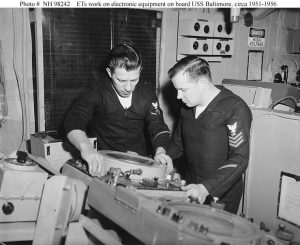
The ET rate was originally established during World War II in 1942 as Radio Technician (RT).
In 1945, the rating name was changed to Electronic Technicians Mate (ETM).
In 1948, the name was shortened to Electronics Technician (ET).
In 1998, the Data Systems Technician (DS) rate was de-established. Former DSs became either ETs or FCs.
In 2015, they were split into four separate ratings:
- Electronics Technician (ET)
- Electronics Technician, Submarine, Communications (ETR)
- Electronics Technician, Submarine, Navigation (ETV)
- Electronics Technician, Nuclear Power (ETN)
Jump To A Section
Requirements and Qualifications
To become an Electronics Technician in today’s Navy, there are specific requirements and qualifications to meet:
- Must be a member of the U.S. Navy.
- Must be a U.S. citizen.
- Must be between the ages of 18 and 39.
- Must have no record of adversely adjudicated drug abuse offenses.
- Must have normal hearing.
- Must have normal color perception.
- A Department of Defense (DoD) security clearance is required.
- Must have an Armed Forces Vocational Aptitude Battery (ASVAB) score of AR (Arithmetic Reasoning) + MK (Math Knowledge) +EI (Electronics Intelligence) + GS (General Science) of >=222 OR a score of AR+2MK+GS>=230
Related Article: Navy Height And Weight Standards
Training and Career Path
Prior to becoming an Electronics Technician in the Navy, you must first become a sailor.
Recruits accomplish this via successful completion of Navy Recruit Training, commonly referred to as Boot Camp.
All sailors attend Boot Camp at the Recruit Training Command, Great Lakes (RTC Great Lakes).
Located at Naval Station Great Lakes in North Chicago, Illinois, in Lake County, RTC Great Lakes is commonly referred to as “The Quarterdeck of the Navy.”
Boot Camp is 10 weeks long. During these 10 weeks, the Navy will teach you the basic skills required of all U.S. Sailors.
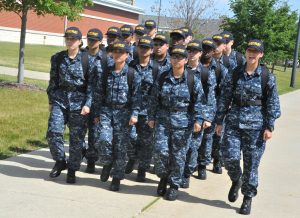
Navy Electronics Technician Class “A” School
After Boot Camp, future Electronics Technicians attend Navy Electronics Technicians (ET) Class “A” School also at Naval Station Great Lakes, Illinois.
Prior to attending ET “A” school, however, they must attend Apprentice Technical Training (ATT) at Great Lakes.
Here they learn basic electronics and electronic circuitry, digital theory, fiber optics, trouble-shooting techniques, safety, microcomputers, and test equipment.
Instruction is both computer-based and laboratory application, with multiple-choice tests and practical lab performance tests.
Related Article – Navy Electronics Technician (AT): Career Details
Apprentice Technical Training is 11 weeks.
Upon completion of ATT, Electronics Technicians move on to the 19 weeks long ET “A” School.
In Electronics Technician Class “A” School, via self-paced computer-based training and laboratory application, ET’s learn Communications Suite (SATCOM, HF receiver/transmitter), 2D Surface radar transmitters/receivers, and Radar Display.
Upon successful completion of “A” school, they head directly to advanced Electronics Technician “C” School.
The “C” school(s) that an Electronics Technician is sent to is based on the Navy Enlisted Classification (NEC) with which they will be designated.
There are 62 ET-related NECs. Just a few of these include:
- Tactical Communications Maintenance Technician (NEC Code: 1402)
- Meteorologist Equipment Maintenance Technician (NEC Code: 1413)
- Special Maintenance (SHF SATCOM System) Technician (NEC Code: 1468)
- FFG-7 Class Navigation Electronics Subsystem Technician (NEC Code: 1491)
- Fleet Electronics Calibration (FECL) Technician (NEC Code: 1589)
- High-Frequency Radio Group (HFRG) Maintenance Technician (NEC Code: 9607)
- AN/SPS-67(V)5 Radar Technician (NEC Code: 9615)
- Miniature/ Microminiature Module Test and Repair (2MTR) Technicians (NEC Code: 1591)
- Air Traffic Control Communications Technician (NEC Code: 1570)
- Communications Security (COMSEC) Maintenance Technician (NEC Code: 1460)
The location and length of the ET “C” school(s) they attend depends on the NEC(s).
Prior to deploying to the fleet, Electronics Technicians can spend up to two years in technical training (not including Boot Camp).
During their technical training, ETs have to work hard. ET3 Jada Smith, now with the Construction Battalion Maintenance Unit 202, in Little Creek, Virginia, finished second in her “A” school class.
ET3 Smith offers advice for future ETs.
“I studied hard, paid attention in class, and dedicated myself. It was also important that I loved what I was learning.”
They should also obtain their ESWS (Enlisted Surface Warfare Specialist) and/or EAWS (Enlisted Air Warfare Specialist) at their first duty station.
The Navy provides online training to qualified ENs through their Credentialing Opportunities On-Line website, referred to as Navy COOL.
Additional Electronics Technician Class “C” schools may be offered/required as their Navy career progresses based on the manning needs of the Navy.
The Electronics Technician rate requires a 72-month (six-year) service obligation due to the extensive technical training provided/required.
How Much Are Navy Electronics Technicians Paid?
Like the other Armed Services, the Navy bases a sailor’s pay on their rank and length of service.
They may be entitled to other forms of compensation including basic allowance for housing (BAH), basic allowance for subsistence (BAS), and billet pay (sea pay, hazardous duty pay, etc.) if eligible.
Related Article – How To Join The US Navy
What’s Life Like as a Navy ET?
The Navy’s Rating Information Card describes the rate as:
“Electronics Technicians maintain and repair electronics equipment such as radar, communication, and navigation equipment. ETs comprise the basis of the ship’s Combat Systems department aboard ships and are responsible for maintaining the ship’s readiness for combat operations.”
Specifically, a Navy Electronics Technician:
- Is responsible for electronic equipment used to send and receive messages.
- Maintains, repairs, calibrates, tunes, and adjusts all electronic equipment used for communications, detection and tracking, recognition and identification, navigation, and electronic countermeasures.
- Maintains, repairs, calibrates, tunes, and adjusts all electronic equipment.
- Uses and maintains hand tools and portable power tools.
The work environment is all over the ship, inside and out.
They should be prepared to work in tight spaces, inclement weather, and a variety of sea conditions.
Electronics Technicians routinely perform physical work, should have good manual dexterity, be able to function well as a team, and keep accurate records.
Hours are often long and not your typical ‘nine-to-five’ routine.

Navy ETs are motivated, confident individuals that the Navy challenges and allows their true selves to shine.
ETN1 James Conder won the Pre-Commissioning Unit (PCU) Delaware’s (SSN 791) Sailor of the Year for 2018.
“My favorite part of my job is the leadership opportunities that positively affect the lives of other sailors,” ETN1 Condor said.
He adds, “I enjoy staying up to date on cutting-edge science, technological advancements, and politics.”
ET2 Kari Wilson of the USS Rushmore (LSD 47) has certainly been surprised in herself by the challenges that the Navy has presented her.
“The best part of being in the Navy has been finding my true potential.”
“Before I joined, nothing would push me the way I push myself here. Before the Navy, the most I’d done with electronics was screw in a light bulb.”
“I never thought I could do the things I do in my job. It makes me believe in myself a lot more.”
For the USS Hawaii’s (SSN 776) Chief Petty Officer Travis S. Reed, serving in the U.S. Navy is a family tradition.
“My father and grandfather were in the Navy, They influenced my choice of service. My father also served on submarines. He didn’t push me to join but hearing him talk about it growing up, I knew that I would want to do it.”
Adds ETC Reed, “I have a lot of pride in what I do day-to-day. I get a feeling that what I do matters. Before the Navy, jobs were just jobs. This is a whole way of life that is meaningful.”
Related Article – Navy Aviation Support Equipment Technician (AS): Career Details
Typical Rotation
Sailors in specific jobs (or rates as the Navy refers to them) must adhere to a Sea/Shore rotation based on their rate.
The Electronics Tech rate is a sea-intensive rate.
During a twenty-year career in the Navy, they will spend about 60 percent of their career at sea, and 40 percent assigned to shore stations.
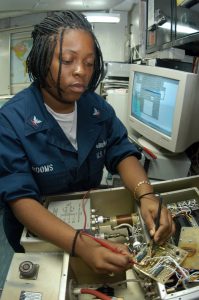
Throughout an Electronic Technician’s career, manning conditions at sea may require the need to request sea tour extension or shore tour curtailments to ensure adequately manned sea billets.
Specifically, the Sea/Shore rotation is:
| Tour | Sea Tour | Shore Tour |
|---|---|---|
| First Tour | 54 Months (4.5 Years) | 36 Months (3 Years) |
| Second Tour | 48 Months (4 Years) | 36 Months (3 Years) |
| Third Tour | 36 Months (3 Years) | 36 Months (3 Years) |
| Fourth Tour | 36 Months (3 Years) | 36 Months (3 Years) |
| Fifth Tour | 36 Months (3 Years) | 36 Months (3 Years) |
| Sixth Tour | 36 Months (3 Years) | 36 Months (3 Years) |
| Seventh Tour | 36 Months (3 Years) | 36 Months (3 Years) |
Note that some overseas assignments count as sea tours.
Shipboard life and life on shore duty are drastically different.
The Navy expects Electronics Technicians, as they do all their sailors, to adapt and meet the challenges presented by these different environments.
Here are a few reviews we happened across on indeed.com from ex- and current Navy ETs:


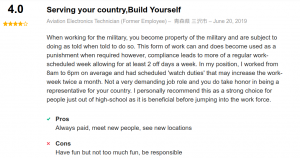

They also enjoy the same benefits as do all Navy personnel, such as the opportunity to travel the world, unlimited opportunities for learning and advancement, and control over their career.
Civilian Career Opportunities
Civilian career opportunities are plentiful for former Navy Electronics Technicians.
These include:
- Computer User Support Specialist
- Computer, Automated Teller, and Office Machine Repairer
- Database Administrator
- Electronics Engineer
- Electronic Home Entertainment Equipment Installer/Repairer
- General and Operations Manager
- Electronics Engineer (Except Computer)
- Information Security Analyst
- Network and Computer Systems Administrator
- Telecommunications Equipment Installer and Repairer (Except Line Installers)
- Electrical and Electronics Installer and Repairer (Transportation Equipment)
- Radio Operator
- Helper (Installation, Maintenance, and Repair Worker)
- Electronics Engineering Technician
- First-Line Supervisors of Mechanics, Installers, and Repairers
- Electrical and Electronics Installer and Repairer (Industrial Equipment)
- Computer Operator
- Computer Network Specialist
- Computer and Information Systems Manager
- Radio, Cellular, and Tower Equipment Installer and Repairer
This is especially true if the sailor takes full advantage of the on-the-job (OJT) training opportunities, and educational opportunities offered and afforded them during their naval service.
Related Article: 10 Best Jobs In The Navy For Civilian Life
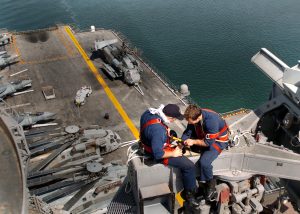
The United States Military Apprenticeship Program (USMAP) also allows them to complete their civilian apprenticeship requirements while on active duty.
According to cool.navy.mil, these apprenticeships include:
- Central Office Repairer
- Computer Operator
- Customer Service Tech Support
- Cyber Database Administrator
- Electric-Motor Repairer (Any Industry)
- Electrician
- Electronics Technician
- Fiber Technician
- Internetworking Technician
- Network Operations Specialist
- Radio Mechanic
- System Administrator
If you are considering the U.S. Navy, are not averse to hard work and long hours, are highly motivated, able to speak and write well, understand modern computing devices, and are seeking adventure, Electronics Technician might just be the rate for you.
Related Article – Dishonorable Discharge: Reasons, Consequences, And More
References
Navy Electronic Technicians (ET) Reviews
Navy COOL Summary For Electronic Technicians (ET)
- Gas Turbine Systems Technician (GSM and GSE): Career Details - June 18, 2024
- Interior Communications Electrician (IC): 2023 Career Details - June 18, 2024
- Religious Program Specialist (RP): 2023 Career Details - June 18, 2024
General FAQ
How long is Navy ET A-School?
Navy Electronics Technicians attend Apprentice Technical Training for 11 weeks, then move to A-School to study for an additional 19 weeks. C-School is based on their specialty and can last up to 12 weeks.
What ASVAB scores do you need to be a Navy Electronics Technician?
To become a Navy Electronics Technician, you’ll need a combined score of 222 in the Math Knowledge, Electronics Intelligence, General Science, and Arithmetic Reasoning portions of the ASVAB. Alternatively, you'll also qualify if your AR+2MK+GS is over 230.
Do you need a security clearance to be a Navy Electronics Technician?
To become a Navy Electronics Technician, you’ll need to be a U.S. citizen and qualify for a DoD security clearance.
What kind of equipment do Navy Electronics Technicians work on?
Navy Electronics Technicians work on communications systems, radios, navigation systems, radar systems, and air traffic control communications.
How long do Navy Electronics Technicians need to enlist for?
Because they receive extensive and advanced training in their special, Navy Electronics Technicians must enlist for a term of six years.

